Backtracking Birds Show Islands are not Evolutionary Dead Ends
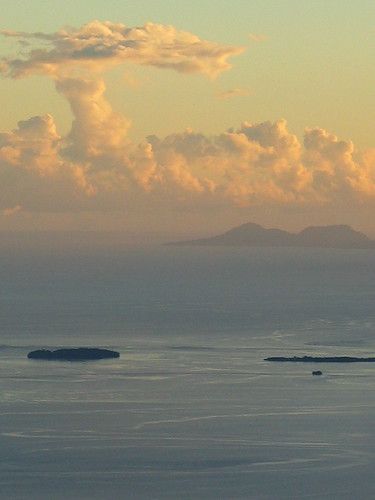
Kolo Sunset.
Photo credit: Christopher E. Filardi,
American Museum of Natural History
(Click on image for a larger picture).
Finally, dear readers, I can tell you the news that I have hinted at on my blog several times during the past few months! Two of my ornithologist colleagues, Chris Filardi and Rob Moyle, published a paper yesterday in the top-tier research journal, Nature. This paper is especially exciting because it shows that oceanic islands are not necessarily the evolutionary "dead ends" that they have traditionally been portrayed to be. In fact, Chris and Rob's data show that a group of birds have actually accomplished what scientists had never previously been able to document; some island species doubled back and successfully re-colonized the continents from where they originated.
Historically, scientists thought that continental species colonize island chains by hopping from one nearby island to the next in a stepping-stone fashion as they progressively moved away from the mainland. This "stepping stone hypothesis" was based on traditional methods for categorizing measurements of certain physical characteristics, such as beak shape, collected from different bird species. These morphological data were analyzed to build family trees based on the numbers and relative similarities of shared physical characters between bird species found on different islands. Using these data, taxonomists thought that those island bird species that most resembled each other also tended to be located within the same island chain, while remote islands hosted birds that were more distantly related. Thus, traditional hypotheses about speciation were built upon the assumption that geographically isolated species were also most likely to be evolutionarily distant.
However, many of these physical characters, especially beak shape, were later discovered to be particularly malleable and will quickly change in response to environmental demands. Because birds located on neighboring islands often live under comparable environmental demands, those particular morphological characters tend to be similar, even when the birds are not closely related. As a result, traditional taxonomic methodologies can provide data such that distant relatives are erroneously classified as close cousins.
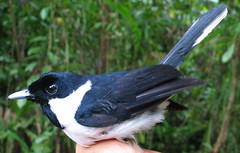 The model system supporting the stepping stone hypothesis are the Monarch Flycatchers (Monarchidae), an Australasian family that comprises approximately 60 species of birds. These small- to medium-sized passerines are also widespread throughout the islands and archipelagos of the Pacific Ocean as the result of historic colonization events. Island Biogeographer Ernst Mayr, who first proposed the stepping stone hypothesis, completed most of the studies of this group using traditional taxonomic methods. These taxonomic data suggested that species colonize island chains by moving in only one direction -- away from continents. Because the biological traffic appeared to be one way, this implies that islands are evolutionary dead ends, which is one of the predictions of the stepping stone hypothesis. But the DNA data from the Monarchs conflict with the taxonomic data, and reveal that this is not necessarily always true.
The model system supporting the stepping stone hypothesis are the Monarch Flycatchers (Monarchidae), an Australasian family that comprises approximately 60 species of birds. These small- to medium-sized passerines are also widespread throughout the islands and archipelagos of the Pacific Ocean as the result of historic colonization events. Island Biogeographer Ernst Mayr, who first proposed the stepping stone hypothesis, completed most of the studies of this group using traditional taxonomic methods. These taxonomic data suggested that species colonize island chains by moving in only one direction -- away from continents. Because the biological traffic appeared to be one way, this implies that islands are evolutionary dead ends, which is one of the predictions of the stepping stone hypothesis. But the DNA data from the Monarchs conflict with the taxonomic data, and reveal that this is not necessarily always true. "The original source [for these birds] was continental, but if you look at island lineages and analyze all the unique forms at once, as we have, you find that the Pacific is an engine of diversity ... that can contribute to continental diversity," explained Chris Filardi, lead author of the paper, in a late-night telephone conversation.
These data were exposed using powerful DNA technologies that quickly reveal important details that were previously undetectable by traditional taxonomic methodologies. These DNA data were statistically analyzed to build a family tree, known as a phylogeny, for these birds (Figure 1, below).
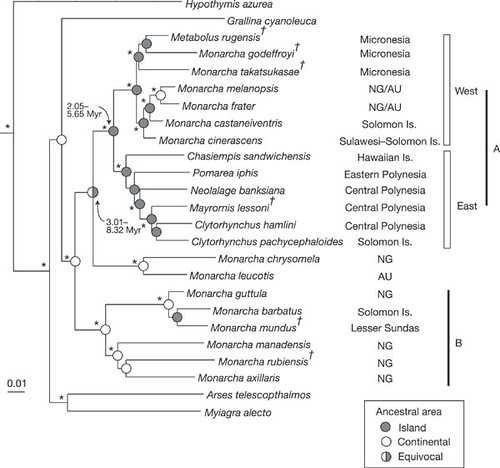
- Figure 1: The tree is rooted with Machaerirhynchus and Rhipidura (not shown). Daggers indicate taxa for which DNA was extracted from museum study skins and are represented by mitochondrial DNA only. Asterisks indicate nodes receiving more than 0.95 posterior probability and/or more than 70% maximum-likelihood bootstrap support. General geographic distributions are indicated to the right of taxon names. Ancestral area assignments for nodes are based on maximum-likelihood-based reconstructions (see Supplementary Information for details). Node age ranges were estimated with rates of 0.01 and 0.0276 substitutions per site per lineage per million years (see Supplementary Information). NG, New Guinea; AU, Australia. [Click image to see larger version in its own window].
The resulting phylogeny suggests that speciation patterns of the Pacific Monarch Flycatchers are more subtle and complex than previously thought. For example, these birds diversified from a single continental colonist which then expanded outward from its island home (Figure 2, below) – instead of speciating after a recurring series of colonizing island "hops" away from Australasia, as implied by the older taxonomic data.
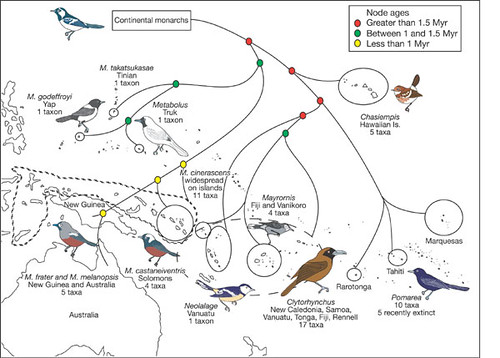
- Figure 2: Bird drawings are roughly to scale and illustrate some of the marked morphological differentiation between island endemics that has complicated the evolutionary interpretation of the group. Coloured circles indicate three classes of node age by using point estimates from ND2-specific rate calibration. Branch lengths are not to scale. The image representing the continental monarchs (Monarcha verticalis) is typical of taxa within clade B (Fig. 1). Large hatching outlines the distribution of Clytorhynchus and small hatching outlines the range of M. cinerascens. [Click image to see larger version in its own window].
According to Rob Moyle, co-author of the paper, the DNA data also revealed that the oldest monarch lineages inhabit the most remote Pacific islands while younger species groups are closer to the continental source area, New Guinea. This finding is contrary to "stepping stone" predictions. Additionally, the DNA data show that species that were previously classified into six different groups, or genera, are actually embedded within another genus, Monarcha (Figure 1). This shows that the birds are actually more closely related than suggested by their physical characteristics alone.
These data will refine our understanding of the role of oceanic islands as potential sources of global biodiversity.
"People have always assumed that the source for biodiversity has been continents," said Chris Filardi. This is because the proposed barrier that prevents island species from successful re-colonization of continents is the complexity of their floral and faunal communities, which islands lack.
This research will undoubtedly have important ramifications for identifying conservation priorities for oceanic islands.
"Islands aren't just little landforms worth saving as icons of evolutionary quirkiness ... They are important in a broader sense and may contribute significantly to future diversity of life on earth," Chris Filardi concluded.
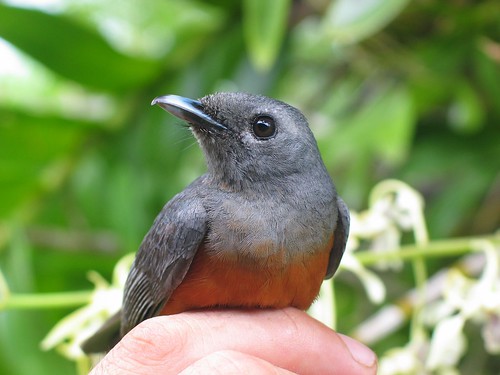
Female White-capped Monarch, Monarcha richardsii, in hand.
This species is endemic to the Solomon Islands.
All photographs appear here with permission from Christopher E. Filardi, American Museum of Natural History.
Sources
Single origin of a pan-Pacific bird group and upstream colonization of Australasia (2005). C Filardi and R Moyle. Nature. (You can request a PDF of the original article from Chris by going to First Paragraph and writing to his email address shown there).
Island birds show evolution is no one-way street (Reuters).
Special thanks to my colleagues, Chris and Rob, for trusting an excitable itchy-fingered scientist-blogger with their manuscript for so many months, and to Chris for sharing some of his wonderful photos here. Also thanks to PZ Myers for telling me the secret scanner-free method for grabbing images from Nature papers so I can share them all here with you.
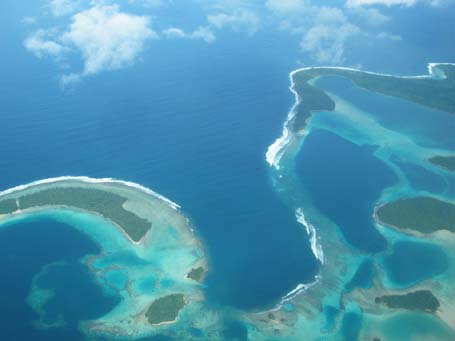
Included with "The Best Science, Nature and Medical Blog Writing" by The Tangled Bank,
Issue #42.
tags: evolution, biogeography, ornithology, birds, avian
© 2004, 2005, 2006 by GrrlScientist











15 Peer Reviews:
This is so cool! Are the photos up? I can see the photo with the beautiful clouds but that is all.
There is at least one photo of a monarch species on its way and I am also trying to get the figures from the paper up, too. (I think one of the monarch photos will headline tomorrow's Birds in the News and the other will appear here -- still deciding what to do with those photos). So after those things are added, the text of this article will be rewritten a little tomorrow to reflect those added materials. But I had to publish this essay today because I promised that I would do so.
GrrlScientist
Ok, I am a non-scientist living and working with scientists. Help me a little here. Can this not be a "back wave" of speciation as opposed to the former belief. If the species started on the remote island, I don't see how it got there. I am probably totally misreading this blog and should read the article itself! If this is birds starting on the continent and then going to the remote island and then returning to the continent...that I understand and it does not surprise me. I hope I haven't revealed too much ignorance here.
Good questions, Tabor, and you are correct. I will be posting the figures from the paper today and that will hopefully make things clearer. To clarify, the original island colonist was from Australasia. That species gave rise to a bunch of new, younger species that are spread all over the Pacific Islands. Several of those younger species were able to go back to the mainland from where their original ancestor came and re-colonize those areas. Keep in mind that when species re-colonize an area, they are again speciating.
The thing that makes this so interesting and exciting is that (1) this biogeographic speciation pattern has never before been documented by science. It gives us hope to see that islands can also act as a source of biodiversity.
(2) it was always thought that species only can move away from mainlands to ever more remote islands, and they can never return due to the huge distances that must be crossed. Further, it was thought that as these new species adapt to island life, they lose their "competetive edge" that is necessary for survival on mainlands, which are species-rich (and therefore, more competetive) when compared to species-poor islands.
I hope this helps!
GrrlScientist
Very interesting work. Thanks for sharing it.
It makes sense, too. After all, if birds went one way, they can go the other, it would seem.
If they respond to pressure to adapt the island, then they should be able to adapt back.
This is out of my field, so I had not realized that there was such an ingrained belief (or so I gather from what you said) that the migration was all one way. That is how it is often portrayed on the nature shows on PBS, but those are for a general audience, so they tend to just hit the high points.
Astroprof; this response is from Rob Moyle, the paper's co-author; Its true, species do re-invade the geographic areas of their ancestors. However, the point with the monarchs is that they re-colonized continental areas, not other islands. The complexity of continental faunas and ecosystems is the proposed barrier to island species' successfully re-colonizing them, not the distance.
GrrlScientist
Neat! I read this earlier today on here, but came back to check out the pictures. It makes sense to me, but it is always good to have some empirical data to back it up. I'm from Hawai'i originally and it is sad how much the populations of these older island species have suffered or even disappeared.
aloha
psilo
Psilo; I am glad that you saw the more finished article with the pictures and figures. I originally posted it with only one picture (the sunset) because my computer battery died before I could get the rest of the pictures added. But I had promised I would post it on Thursday, so I left it that way until friday, when I was able to add everything else. The figures required a little asking around before I added them, too, but thanks to PZ, they are here.
Xavier; the photos belong to Chris, so you will have to ask him to use them. The color figures can be found on the html version of the paper on the Nature site.
GrrlScientist
I know these birds! I used to live in the Marianas. The Tinian Monarch, unique to that small island, is a beautiful little creature.
But this article raises... well, an awful lot of questions. The idea that island birds are not competitive has a lot of empirical support. (Like, the fact that island bird species are in trouble all over the world.) A lot of the native species in the Marianas are struggling just to keep up with imported continental birds, never mind predators.
Island birds like the Tinian Monarch have pretty regularly gone extinct when faced with competent continental predators. Rats, hogs, cats... the brown tree snake, a single introduced species on Guam, has wiped out five or six endemic birds.
So how do ecologically naive island birds manage to recolonize a continent? It's a fascinating notion, but I'd want to see a lot more support before buying in.
Doug M.
Thanks, Hedwig... it's a fascinating post, one of those that explain exactly how scientific research is done, rather than just watering down the situation to high-school level. Color me impressed.
Doug, is the situation you describe so necessarily because island birds are uncompetitive, or merely because they haven't evolved to resist these predators? Many species unique to the Americas, Australia, and New Zealand got wiped out when humans arrived because they'd never known any humans and so hadn't evolved to run away from them.
I am just a layperson and am hoping the biogeographers might comment on this thought...do you think that the geography of this area of the Pacific is more like a "continent of islands" than may be found in other continent vs. island areas of the world? Perhaps the unique combination of the physical layout of the lands, the Equatorial location, trade winds, cyclones and monsoons, etc, create more of a "mix-master" that could allow island populations to return to the continent more successfully?
hey, i found your note on craigslist sciforum. didn't get a chance to read your whole article (don't like sittin in front of computer screen too long) but it's nice to see that some island creatures can get back into the big world. i was hoping so. the birds are cute.
adjuncting sucks.
i just moved to brooklyn and got my first pair of binoculars and am having a ball seein what all those birds are. eastern pheebees and winter wrens are great. also i saw my first yellowlegs which was way cool. you ever read John Janovy's book Yellowlegs? he's an interesting guy. messy parasite biologist out in nebraska.
anyway thanks for the peep into your world.
ps. hang in there, the world needs to keep getting STOPPED and shown something besides terrorist reports and the latest ipod invention!
barry
Doug: this is Rob's reply to your question;
The idea that ALL island species are not competitive actually does not have empirical support. There are certainly some well known cases of island birds being wiped out by competitors, but many of the problems that island birds face are due to habitat loss, and often have nothing to do with competition. Introduced species have similar detrimental effects on continental species, but they are often buffered by immense population sizes compared to island species.
Also, just because some island species are out-competed by invaders does not mean that we should conclude that all island species are not competitive.
Keep em coming!
-Rob
I will post more answers here as they arrive, so please check back!
GrrlScientist
ChardysPal; Rob says
Since we have only looked at one lineage so far, it is too early to say with any certainty. However, at least for some species we do think that the Pacific may be far more complex (ie. continental) than previously believed. As we study more groups, and the monarch flycatchers more intensively, we should have a lot more to say on the topic.
Great article! Do you know what species of monarch is features on the first photo (the black-and-white one)?
Post a Comment
<< Home